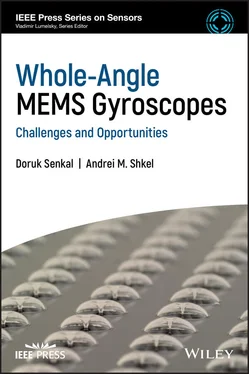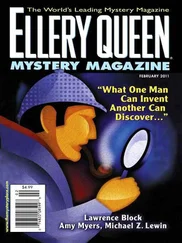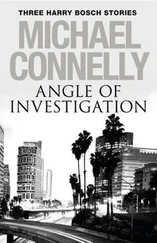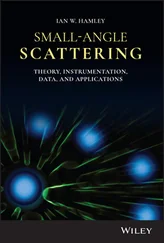Rate ramp, also called the thermal ramp, is caused by temperature changes in the environment, shows up with a slope of .
Periodic oscillations show up as peaks in the Allan Variance curve with an integration time of (not shown). These oscillations are either caused by a periodic event in sensor electronics or the environment, such as day/night temperature cycles or variations in power supply.
The first part of this book focuses on fundamentals of whole‐angle gyroscopes, dynamics, mathematical framework, and control strategies. In the second part of the book, conventionally micro‐machined 2‐D whole‐angle gyroscope architectures are reviewed. The final part of the book focuses on 3‐D emerging micro‐machining technologies for fabrication of whole‐angle gyroscope architectures.
In Chapter 2, Foucault Pendulum analogy is introduced as a starting point for whole‐angle gyroscope dynamics. Later in the chapter, effects of structural imperfections are introduced, along with requirements for continuous RIG operation.
In Chapter 3, a brief overview of control strategies for CVGs is presented. The remainder of the chapter deals with sustaining oscillation and suppression of error sources in whole‐angle gyroscopes, along with methods for tuning and self‐calibration.
Chapter 4provides an overview on two types of conventionally micro‐machined 2‐D micro‐machined whole‐angle gyroscope architectures: lumped mass gyroscopes and distributed mass gyroscopes.
In Chapter 5, two examples of 2‐D micro‐machined whole‐angle gyroscope architectures are reviewed: (i) Toroidal Ring Gyroscope (TRG) and (ii) Dual Foucault Pendulum (DFP) gyroscope. The goal of this chapter is to illustrate factors that influence design decisions, fabrication considerations, and characterization methodology.
In Chapter 6, recent advances in 3‐D shell micro‐technology for fabrication of whole‐angle gyroscopes are reviewed. Starting with a brief history of macro‐scale shell resonator gyroscopes, the chapter focuses on advances in micro‐shell resonator fabrication processes, with an emphasis on transduction mechanisms, characterization techniques, and mechanical properties.
In Chapter 7, the micro‐glassblowing paradigm is introduced for wafer‐level fabrication of atomically smooth, low internal loss Titania Silicate Glass (TSG) and fused silica 3‐D wineglass gyroscopes. Feasibility of the process has been demonstrated by fabrication of fused silica and TSG micro‐glassblown structures.
In Chapter 8, various transduction strategies for micro‐glassblown wineglass resonators are presented. Two methods of electrostatic transduction are reviewed in this chapter: (i) in‐plane electrodes and (ii) out‐of‐plane electrodes.
Finally, the book is concluded in Chapter 9with an outlook of future trends.
Конец ознакомительного фрагмента.
Текст предоставлен ООО «ЛитРес».
Прочитайте эту книгу целиком, на ЛитРес.
Безопасно оплатить книгу можно банковской картой Visa, MasterCard, Maestro, со счета мобильного телефона, с платежного терминала, в салоне МТС или Связной, через PayPal, WebMoney, Яндекс.Деньги, QIWI Кошелек, бонусными картами или другим удобным Вам способом.












